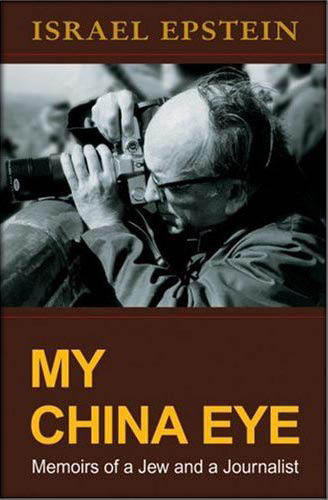Documenting China’s Changes from an Original Perspective
By staff reporter ZHOU LIN My China Eye – Memoirs of a Jew and a Journalist Author: Israel Epstein Price: US $24.95 Hardcover, 360 pages Published by Long River Press

PUBLISHED in 2005, My China Eye – Memoirs of a Jew and a Journalist by Israel Epstein gives an account of the hundred years of turbulence and struggles in recent Chinese history. Today, a decade after it was first published, the work is still relevant, not least because the year 2015 is the 70th anniversary of China’s victory in the war of resistance against Japanese aggression and end of the World Anti-Fascist War. It also marks the centenary of the birth of the author.
Israel Epstein, distinguished correspondent and author, wrote several books and countless news reports on the course of China’s revolution, reconstruction, and reform. They include The People’s War, The Unfinished Revolution in China, Tibet Transformed, and From Opium War to Liberation. All express his deep affection for the Chinese people and contribute significantly to mutual understanding and friendship between China and the rest of the world.
Epstein was born in Poland in 1915. His parents, Polish Jews and socialist revolutionaries buffeted by the historical currents during WWI, fled with their two-year-old son to China in 1917. After a short spell in Harbin the family moved to Tianjin, where Epstein attended the American School. Although immersed in Western culture, his growing up in a semi-colonial China suffering invasion, exploitation, and humiliation at the hands of imperialist countries imbued in Epstein a deep empathy with the common Chinese people.
At age 15, Epstein took up journalism and went on to devote himself to wartime reporting on the Chinese people’s sufferings during their eight years of blood-soaked resistance against Japanese imperialists.
The outbreak of the full-scale Japanese invasion was sparked by the Lugou Bridge Incident in July 1937. Epstein personally heard the first gunshots there that signaled this turning point. From then on, he threw himself wholeheartedly into wartime reporting.
As war correspondent for the United Press he survived countless air raids and witnessed both the brutality of invaders and the heroism of the people under attack, including the fierce defense of Tianjin. He also reported on the Tai’erzhuang campaign, a heartening victory against the Japanese, and interviewed Kuomintang Commander Li Zong-ren and some of his soldiers.
Amid Japan’s aerial bombardment of Guangzhou Epstein interviewed people on the city’s streets. It was during a torch-lit patriotic parade there in 1938 that he first met Madame Soong Ching-ling, widow of Sun Yat-sen. So began a close friendship that spanned more than four decades. Shortly after Madame Soong invited Epstein to join the Hong Kong-based China Defense League, which she had founded. He was responsible for publishing Newsletter, the league’s bi-weekly periodical.
Early in 1939, Epstein published his first book The People’s War, in London. Based on his firsthand observations and reports, it told the world of the Chinese people’s unremitting resistance and heroic stance against Japanese invaders.
Epstein’s most memorable experience was his visit to Yan’an in the early summer of 1944. He and other foreign and Chinese correspondents broke the Kuomintang news blockade and headed for the revolutionary base to see what was really happening there. From Chongqing to Yan’an, Epstein reported on life in the Communist-held region, based on his interviews with Mao Zedong, Zhu De, and Zhou Enlai, in whom he saw the future of China.
In a letter to his wife, Elsie Fairfax-Cholmeley, Epstein wrote, “There are probably more varied activities in Yan’an than in all other parts of China and certainly more really active people. And these people are amply sure that they are China’s future.”
His interviews with Mao, when the Great Helmsman expounded on his conviction that democracy and a joint effort by Kuomintang and Communists were essential in fighting Japanese invaders, left a deep impression. Epstein admired Mao’s ability to express complex strategic ideas in a simple yet unforgettable manner.
The chapter on Tibet stands testament to Epstein’s superlative journalistic prowess. Between the 1950s and 1980s he made four trips to Tibet, each lasting one to two months, despite the rigors of the region’s high altitude. The first was in 1955, when he traveled overland in a jeep from Sichuan’s capital Chengdu over mountain passes and deep ravines. He made the second, third and fourth trips by air.
While on the “Roof of the World” he visited 700 to 800 local residents. His notes over the period totaled one million words. To present the real Tibet to the world convincingly, he made an exhaustive study of foreign writings on the autonomous region. The book he eventually finished combined personal observations with the deep insight he had thus gained into Tibetan history, especially in the modern era.
The book is unique not only by virtue of the extent of time it covers – from 1915 and earlier to the 21st century – but also the particular angle through which Epstein presented China, from the inside but through a world perspective.
More important, Epstein was both a participant in and witness to the Chinese transformation. As he himself noted, “Unlike outside observers, we saw the international arena as it appeared from within China. Bearing in mind our familiarity with both worlds, our perception might help give others a more rounded view.” This book, therefore, is mandatory reading for all who are interested in China, its past, present and future.
